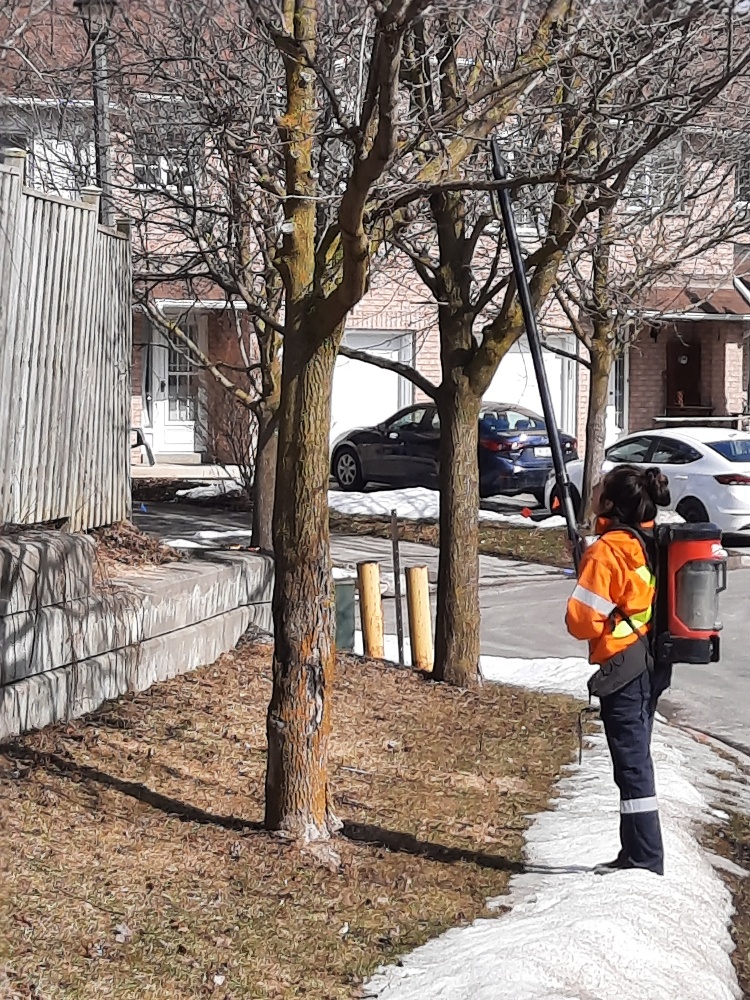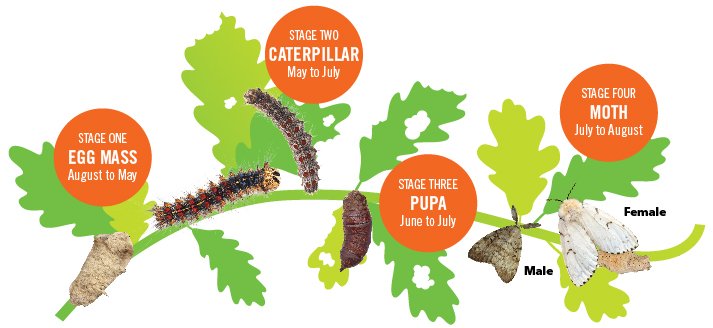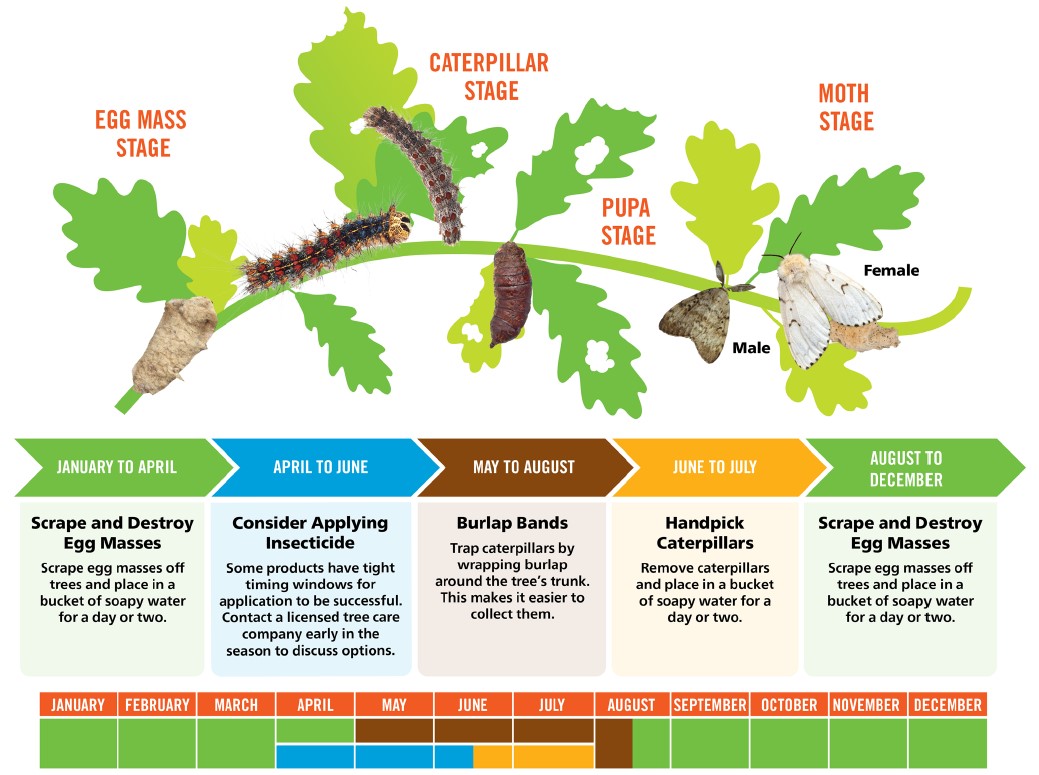Protect your Trees: Lymantria Dispar Dispar (LDD)
One piece of free pre-cut burlap wrap will be available per household at various locations across EG.
Learn more and find a giveaway location
Please note that you cannot purchase additional burlap from the Town or these locations.
Where can I purchase burlap in EG?
What are LDD?
Lymantria Dispar Dispar (LDD), previously known as Gypsy moth, now known as Spongy Moth, is an invasive species that is found throughout Ontario. In their caterpillar stage they feed on many types of deciduous trees (oak, maple, elm, birch, etc.) and during outbreaks are also known to feed on coniferous trees (white pine, spruce, etc.). Outbreaks are cyclical, typically occurring every 7 to 10 years and lasting anywhere from 1 to 3 years. The caterpillars feed on leaves and cause damage for a short period of time, normally June and July. Most deciduous trees will generate a second set of leaves when the weather is favourable, with periodic rain, or irrigation. Most coniferous trees will not recover from severe defoliation as they are not able to regenerate needle growth.
To learn what types of trees you have on your property, visit the Forests Ontario website.
Current LDD stage
LDD moths are now in the caterpillar stage. Residents are encouraged to check their trees for caterpillars and remove, destroy, and dispose of them. They can do so by either trapping or hand picking the caterpillars and disposing of them by submerging them in a bucket of soapy water for a day or two. For more information, please read the caterpillar stage below.
Identifying LDD
LDD have four different stages in their life cycle and look very different throughout each stage.
| Life Cycle of LDD |
|
The LDD lifecycle has four stages:
The timing of each stage depends on climate and location.
|
| Pupae/Cocoon and Egg Mass stage |
|
Egg Masses:
Cocoons/Pupae:
Photo Gallery: LDD will appear here on the public site.
Find step-by-step instructions for removing LDD under managing LDD. |
| Caterpillar Stage |
LDD Caterpillars:
Find step-by-step instructions for removing LDD under managing LDD. |
What can residents do?
Property owners are responsible for managing trees (and pests) on their property. Residents are encouraged to inspect their trees and take action to remove LDD in any life cycle stage, which will help reduce the level of infestation.
Residents should wear gloves and long sleeves while removing pupae/cocoons and egg masses. Caterpillars secure themselves to leaves and bark then form a cocoon using their hairs as protection, and these hairs can cause dermatological reactions.
| What you should do to protect your trees |
|
Below are various LDD management options that residents may use to lesson the impact of LDD. April to MayBoth the cocoons and the egg masses tend to be located on the underside of branches and on the trunk of the tree. You may also find both attached to clumps of leaves, lawn furniture, wood piles and structures. It is important to remove them during this stage because it will greatly, reduce the number of caterpillars feeding on the trees. To remove the egg masses, follow these steps:
April to June
May to AugustIn the spring and into the summer, caterpillars can be handpicked. Caterpillars can be removed and disposed of by submerging them in a bucket of soapy water for a day or two. To trap caterpillars, follow the steps below:
Note: check your burlap bands daily to ensure birds or any other wildlife don’t get unintentionally caught. If you come across injured wildlife, contact your local Animal Control Services or Wildlife Rescue: |
How the Town is managing LDD on municipal trees

Designated staff are monitoring trees throughout EG and are part of York Region’s Invasive Species Technical Working Group. At this time, no municipalities in York Region are carrying out aerial spraying, the spray may cause harm or kill other species that are helpful to our wider ecosystem.
Town staff were out this spring removing egg masses from Town owned, boulevard trees. Only egg masses within reach from the ground, using a backpack vacuum with wand extension, were removed from boulevard trees. Priority was given to trees in hot spot areas first.
Town staff identified a healthy population of NPV, a virus that kills the LDD caterpillars, present in the Tall Pines, Donaldson, Artesian area. The virus is host specific and will only be harmful to the LDD species. It will not affect the trees, pets, or people.
Roads and Sidewalks
The Town brought in the Operations team, using the sidewalk plow/sweeper and road flusher, to assist in dealing with the abundance of caterpillars and debris on the ground in heavily impacted areas last year.
Roads and sidewalks will be monitored again this year and if cleanup is required it will be scheduled accordingly.
Frequently Asked Questions
|
Where did LDD come from? |
| This invasive species was introduced to the United States in the late 1800s and was first detected in Ontario in 1969. |
|
Are LDD harmful? |
|
They are most destructive in their caterpillar stage as they eat leaves from a large variety of trees. Most healthy deciduous trees can grow a second set of leaves, but conifers are more vulnerable because they aren’t able to produce new needles. Repeated defoliation can cause considerable stress to the tree which can weaken its defenses to other pathogens and vectors. Factors such as drought, during defoliation, can also increase the amount of stress on the tree. Frequent irrigation will help to lesson the stress and promote the second flush of leaves. |
|
What types of trees are affected most? |
| LDD caterpillars will eat the leaves on most tree types, but Oak trees tend to be favoured. During years of peak outbreaks caterpillars are known to feed on coniferous trees as well. |
|
Where can I purchase burlap? |
|
Burlap can be purchased at most local hardware stores:
|
|
Why does the Town focus on municipal trees? |
| Trees located on private property are the responsibility of the homeowner. If you need assistance, it is recommended that you contact a licensed tree care company or specialist. There are also things residents can do to help protect their trees. |
|
I have an itchy rash. Do LDD bite or sting? |
|
LDD caterpillars do not bite or sting, but many people have an allergic reaction from coming into contact with LDD. This bite like rash is likely caused by the little hairs on the LDD caterpillar coming into contact with bare skin. You may not come into direct contact with the caterpillars but their little hairs can fly through the air and land on skin or clothes, etc. Histamine found in the caterpillar's hair can cause red, itchy bumps to form. The rash is not contagious. Depending on how sensitive you skin is may effect how long it takes to stop itching. Wearing long sleeves, pants tucked into socks, gloves and hats may help prevent your skin from coming into contact with the hairs. Especially when handling caterpillars or egg masses when clearing off your tree(s). Consider washing clothing worn outside each day to remove hairs that might still be attached. |
|
Will LDD be back again next year? |
|
LDD outbreaks can last two to three years. Based on estimated populations from 2020 and 2021 (egg mass surveys), these numbers will likely repeat again this year (2022). A defoliation survey (July 2021) and an egg masses survey (Fall 2021) was conducted to help make 2022 predictions about the LDD population. Town staff will continue to monitor municipal trees throughout 2022 to determine 2023 populations. |
|
Will the Town be removing all egg masses from street, park and larger trees? |
|
Town staff are back out this spring removing egg masses from, Town owned, boulevard trees. Only egg masses within reach from the ground, using a backpack vacuum with wand extension, will be removed from boulevard trees. Priority will be given to trees in hot spot areas first. Other streets will be worked through systematically as staffing time allows. |
|
Can I request to have the eggs masses removed from my street tree? |
|
Unfortunately, the Town does not have the capacity to take requests to remove egg masses in specific areas in EG. Through ongoing monitoring Parks staff are aware of the streets with concerning amounts of egg masses and will be working systematically through each street. We are not currently asking residents to contact the Town with egg removal requests. |
|
Do LDD have natural enemies? |
|
NPV, nuclear polyhedrosis virus, a virus that is host specific and does not affect trees, pets, or people. Entomophaga Maimaiga, a naturally occurring fungus helps to reduce the population of LDD when it increases to high levels. It is not dangerous to humans or pets. Multiple species of birds, squirrels, chipmunks, raccoons, skunks, and native insects are also natural predators of LDD. |
|
My evergreen was eaten by LDD caterpillars last year. Is it dead? |
|
Unfortunately, conifers are not able to regenerate needles, if severely defoliated they are not likely to recover or survive. Contact an arborist for private tree assessments and removal services. Residents that are considering tree removals do not require a tree removal permit from the Town of East Gwillimbury. |
|
Can I spray LDD on my property using a private company? |
|
Yes, residents have the option to treat their private trees. Bacillus Thuringiensis var. Kurstaki (BTK) spraying is one option. BTK is a naturally occurring bacterium used to kill and control caterpillars. The caterpillars will stop feeding immediately after ingesting BTK. When used as directed, it has no effect on birds, earthworms, or beneficial insects such as honeybees and ladybugs. The first application should be applied when leaf buds first start to open, and the second application should occur approximately one week later. BTK becomes inactive after about a week and is harmless in the environment. |
Resources
Contact Us
Our Customer Service Team is here to help!




